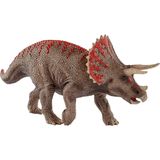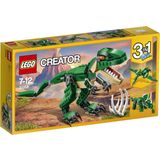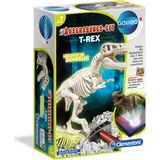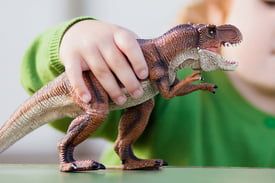Dinomania - On The Trail Of Primaeval Giant Lizards
The era of the dinosaurs ended on our planet about 65 million years ago, but our fascination with the life of prehistoric lizards is still unbroken. T-Rex etc. are particularly popular with children. So you don't get embarrassed when talking shop with your little Dino fans, we're going on a journey through time to a world long gone. We'll also present you with a who's who of the most popular specimens.
Name search
It was the British naturalist Sir Richard Owen who gave the dinosaurs their name. It's composed of the Greek words deinos (terrible) and sauros (lizard). The "terrible lizards" belong to the group of sauropsids - reptiles as well as birds that lived on land, in the air and in the water. When a new dinosaur is discovered, it is usually named after the person who discovered it (Megalosaurus bucklandi) or after the place where it was found (Argentinosaurus).

Around the world
At the time of the dinosaurs there were no continents, but a single, connected landmass (Pangaea). Over time, the tectonic plates drifted apart - with the dinosaurs living on them carried away. That's why today dinosaur bones can be found all over the world.
Everything has an end
We cannot say with certainty what started the demise of the primaeval lizards. It was probably the impact of a huge meteorite that triggered rapid climate change. It could also have been multiple eruptions of mega-volcanoes in quick succession, sea levels falling too quickly, or a combination of all three theories.

Look at the family tree
Scientists suspect that birds evolved from the group of coelurosaurs. Finds of these two-legged, slender carnivores suggest a thread-like skin structure. This in turn could have evolved into the later feathers. In addition, with the Caudipteryx and the Protarchaeopteryx, two specimens were found that actually had a full plumage.
Legendary discoveries
Even if modern dinosaur research has only existed since the 19th century, fossils of the primaeval inhabitants were apparently found thousands of years ago. The people of that time could not explain the unusual bone remains, which probably contributed to the spread of legends and myths about dragons, griffins and other mythical creatures. As late as 1677, people believed they had found a giant's femur. Only much later could the find from Cornwell, Oxfordshire be assigned to a Megalosaurus.

Flex those muscles
Huge in size, with pointed horns, sharp teeth and in a dangerously bad mood - children are attracted to dinosaurs. They can pretend to be these powerful animals while playing and can finally feel big and strong, says psychology. The Battle of the Giants also allows them to explore unexplored concepts such as danger, violence, victory and defeat in a safe setting.
A superstar is born
The first life-size dinosaur sculptures were presented to the public in London in 1851. This was a defining moment that would capture people's imaginations for generations to come. Starting with Jules Verne's novel "Journey to the Center of the Earth" (1864) and the adventure film "The Lost World" (1925), and onto Steven Spielberg's "Jurassic Park", films have triggered a veritable dinosaur boom in 1993 that has continued to this day. Whether it's a colouring pad, a craft kit, a storybook, an action figure, a video game or a movie - dinosaurs are omnipresent in our pop culture.
Important carnivores and herbivores at a glance

T-rex
It's one of the largest carnivores that has ever lived on land. The Tyrannosaurus Rex had a large skull, powerful legs, and distinctively small, two-fingered arms. His dominion was what is now North America. There, he was at the top of the food chain and hunted herbivorous dinosaurs.
- Length: 13 metres
- Height: 4 metres
- Weight: 8.8 tons
- Habitat: North America
- Fun fact: The largest T-Rex tooth found is 30cm long including the root

Velociraptor
Small, fast and extremely dangerous! The Velociraptor was surprisingly light and agile for its size. As a carnivore, it would attack its victims with the sickle-like claws on its hind feet. Its jaw, with 26 to 28 razor-sharp teeth on each side, did the rest.
- Length: 1-2 metres
- Height: 50-100 centimetres
- Weight: 15-20 kilograms
- Habitat: Asia
- Fun Fact: Many finds from China and Mongolia indicate that the Velociraptor had feathers

Spinosaurus
Spinosaurus stands out due to its impressive back spines. The mystery of their function remains unsolved. They probably served to regulate the dinosaur's temperature. It's possible they were also used in courtship to impress the object of desire and to intimidate competitors.
- Length: 16-18 metres
- Height: about 4.5 metres
- Weight: 7-9 tons
- Habitat: North America
- Fun fact: There are many indications that the Spinosaurus hunted on land and fished in the water.

Patagotitan
The Patagotitan was only discovered in the 2010s and amazed dinosaur research. The size of the dinosaur surpassed everything that had previously existed. 6 pieces of the giant were found within 3 years. The herbivorous Patagotitan had small thorn-like appendages on its back. Its head was surprisingly small compared to the rest of the body.
- Length: 37 metres
- Height: about 6 metres
- Weight: 70 tons
- Habitat: South America
- Fun Fact: The femur of a Patagotitan is an incredible 2.4 metres tall

Stegosaurus
With its differently sized bony plates on its back and spiked tail, the Stegosaurus looks really dangerous. However, he wasn't a hunter. He was only after plants, which he sawed up with small teeth. His stooped posture can be explained by the fact that his front legs were shorter than his hind legs.
- Length: 9 metres
- Height: 4 metres
- Weight: 4.5 tons
- Habitat: North America, Portugal
- Fun fact: The stegosaurus' brain weighed an average of just 80 grams, but in all likelihood it was still more intelligent than other modern-day reptiles.

Triceratops
A neck shield and three thick horns - the triceratops knew how to defend itself. However, there are also theories that the shield was not intended to protect against attacks, but was used to regulate heat. The favourite food of this herbivore with the beak-like snout was probably ferns and other herbs.
- Length: 9 metres
- Height: 3 metres
- Weight: 6-12 tons
- Habitat: North America
- Fun Fact: When the end of the dinosaurs came, the Triceratops had "only" existed for one to three million years. It was therefore one of the youngest dinosaur species to become extinct at the time.
Related products
-
 5.0 (2)
5.0 (2)Schleich 15000 - Dinosaurs - Triceratops
- Great to collect
- Robust and play-proof
- Dimensions: 21 x 5 x 9cm
€ 16,99Delivery by January 10
-

LEGO Creator - 31058 Dinosaur
- Creative building fun
- Lots of moving details
- Contents: 174 parts
€ 14,99Delivery by January 10
-

Clementoni Excavation Set - T-Rex
- Glow in the dark
- For hobby palaeontologists
- Includes posters
€ 8,99Delivery by December 23
-
 5.0 (1)
5.0 (1)Ravensburger Jigsaw Puzzle - Dinosaurs, 100 Pieces
- Promotes logical thinking
- Great gift for dinosaur fans
- With Softclick technology
€ 11,99Delivery by December 23
Magazine Articles:
-
Austria: Free standard delivery from € 49,90
-
Free
returns -
Delivery in 3 business days.
More than 6.850 products

